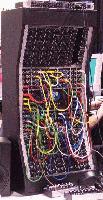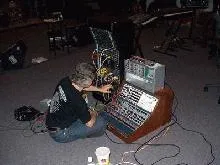
Free download

Abstract and other electronic music
Song Info
Genre
Charts
Peak #155
Peak in subgenre #18
Author
Mike Peake
Rights
2002
Uploaded
December 16, 2003
Track Files
MP3
MP3 6.4 MB • 128 kbps • 0:00
Story behind the song
No compression or limiting is present. Only very minor EQ was used, and a touch of reverb and echo.
Synthesizer used: Selector System "C".
This was created without the use of a keyboard controller, excepting to tune the choral sound to particular frequencies (they weren't triggered by the keyboard). All patches were self-running and self-modifying and were created on the fly without referring to each other, as interesting patches occurred and evolved. (Proof of this are the cyclic noise skritches on the Choral sounds. This is a clock problem between the HD24 and the MOTU, which I was unaware of during recording due not not monitoring anything but the synth's output. I simply kept it as it sounded interesting.) The main concern was editing them into something interesting. Typically, three minutes of each patch was recorded, and was sometimes double- and triple-tracked. The drum section evolved in response to a specific concept, but no sounds were referenced or monitored in the creation and recording of new sounds intended to expand it. Sound design took three days. Two LFOs and an S/H, all modulating each other's rates, fire the envelopes.
For recording, the Selector was patched directly into the MOTU 2408MK2 A/D or Alesis HD24 A/D. All signals were individually run out of the HD24 and 2408Mk2 into an Alesis X2 mixer. External FX used: Lexicon PCM70 (long reverb), Yamaha e1010 analog delay (panned hard left, no feedback), A/DA STD-1 for a single short delay, panned right, EH 16-Second delay on the "pipe organ", Deltalab Acousticomputer for reverb pre-delay, and an Alesis XT:c reverb (rather old) on "snare" and the hard sync stabs leading into the drum section. Some EQ was used, but it was light, and only on a couple of sounds.
The only sections which had manual manipulation were the two intro "bouncing ball" effects, in which I slowly increased the noise level into the S/H to alter pitch and filtering. I could have patched this…
My System "C" consists of three oscillators, two filters, a dual ring modulator, a dual wave shaper, two LFOs, a S/H, two dual envelopes, a single envelope, and two VCAs. The dual ring modulator did not see use in this piece. No tracks were sent back through the synth for additional processing.
-"Pipe Organ", 4:07 Triple Resonator following output of S/H, which is fed the Random Voltage. The S/H is clocked by a modulated LFO. Very musical results! 3 oscillators, saw waves, in octaves, probably also into two Filters in series doing very resonant bandpass, also following the S/H output. The same basic patch as the Choral sound, but without pitch modulation.
-Slow Metal Sweep during drums; also percussive metal at 4:48 and 5:12. Strangely reminiscent of the DX-7! A hard sync'd oscillator into series filters doing bandpass; the LPF is highly resonant. The HPF is fed FM from the sync master oscillator, and the LPF gets it from the sync'd oscillator (sine waves). Oscillator 1 drones in pitch and modulates Filter 1.
-Muted xylophone/marimba and scratchy dry mouth effects Pretty much the same patch. An envelope at minimum times modulates a highly resonant filter which feeds the TRES. All are modulated by S/H. S/H is clocked by a modulated LFO pair. "Dry mouth" is the sound which appears at 2:00.
-Drums Some of them are from sending an envelope with minimum times into the audio in of a filter in self-oscillation. All are run through the TRES. There is audio-rate FM on some, such as the hat and random metallic noise percussion (which evolved into the above metal sweep sound). The S/H clock drives all of the percussion and bass/lead sounds. Note that by 3:45 in the piece it is evident that there is drift in the clock, and that the sections were aligned by hand. The S/H output was mult'd and used to gate the envelopes, which results in the semi-random events. Some were used in ADSR mode with sustain, such as the kick drum. The Selector e
Song Likes
On
Playlists
Comments
The artist currently doesn't allow comments.